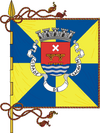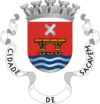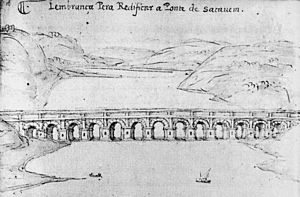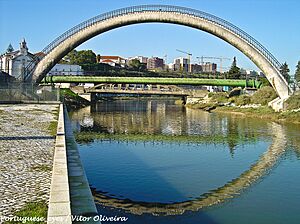Sacavém facts for kids
Quick facts for kids
Sacavém
|
|||
|---|---|---|---|
|
Civil parish
|
|||
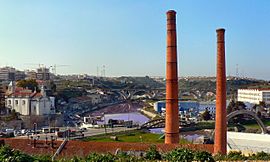
The Trancão River winding through the heart of Sacavém
|
|||
|
|||
| Country | |||
| Region | Lisbon | ||
| Metropolitan area | Lisbon | ||
| District | Lisbon | ||
| Municipality | Loures | ||
| Established | Parish: before 1191 Town: 7 December 1927 City: 4 June 1997 |
||
| Area | |||
| • Total | 4.09 km2 (1.58 sq mi) | ||
| Elevation | 25 m (82 ft) | ||
| Population
(2001)
|
|||
| • Total | 17,659 | ||
| • Density | 4,318/km2 (11,183/sq mi) | ||
| Time zone | WET/WEST (UTC+0/+1) | ||
| Postal code |
2685-099
|
||
| Patron | Nossa Senhora da Purificação | ||
| Website | http://www.jfsacavem.pt | ||
Sacavém is a city in Portugal. It is located in the Loures area, near the capital city of Lisbon. In 2013, Sacavém joined with another area called Prior Velho. The city is about 4 square kilometers big and is home to over 17,000 people. Sacavém is well-known for its pottery-making history.
Contents
History of Sacavém
Sacavém has always been an important place. This is because it sits where several roads meet. These roads connect the north and east of Portugal to Lisbon. Historians believe Sacavém was settled a very long time ago. Some evidence shows people lived here even before the Romans.
The oldest signs of life date back to the Stone Age. Tools like polished stone axes have been found. In the 1980s, a cave was discovered. It contained similar old artifacts.
Roman Times
Around the first century, two major Roman roads crossed Sacavém. These roads linked the region to other parts of the Iberian Peninsula.
- One road connected Lisbon to Mérida in Spain.
- The other linked Lisbon to Braga in northern Portugal.
Parts of these old Roman roads are still under modern streets today. Sacavém was also an important place to cross rivers. The Romans built a bridge here. This bridge was used until the 1600s. It helped connect Sacavém to the land across the river. The city's coat-of-arms even shows this Roman bridge.
After the Romans, different groups came to Sacavém. First were the Alans, then the Visigoths. The Visigoths built a small church. It was dedicated to "Our Lady of Pleasures."
Moorish Rule
In 711, the Moors from North Africa took over the Iberian Peninsula. Lisbon and Sacavém became part of their land. Many people in Sacavém kept their Christian faith. This was allowed because the Moors were tolerant of "People of the Book." This term referred to Christians and Jews.
The name "Sacavém" likely comes from Arabic. Experts believe it came from "šagabi," meaning "next to" or "in the neighborhood." This referred to its closeness to Lisbon. Later, Arabic writings show the name "Šaqabān," which sounds very much like the modern Portuguese name.
Sacavém was a small settlement within the larger Lisbon area. It was ruled by Moorish leaders. In 1093, the Moorish ruler of Badajoz gave Sacavém to Alfonso VI of León and Castile. This was in exchange for help against another group, the Almoravids. But Sacavém returned to Moorish rule for a short time.
In 1147, Afonso I of Portugal captured Lisbon. This marked the end of Moorish rule in Sacavém.
The Middle Ages

An old story says a big battle happened near the Trancão River in Sacavém. This was in October 1147. King Afonso I of Portugal fought the Moors. The legend says 5,000 Moors fought only 1,500 Christians. But the Christians won a great victory. People believed the Blessed Virgin Mary helped them. She supposedly brought many Christians speaking strange languages. These were likely the crusaders who helped take Lisbon that year.
The story also says the Moorish leader became a Christian. He became the first priest of a new church. King Afonso Henriques ordered this church built. He also rebuilt the old Visigoth church. It was renamed "Our Lady of Victory." This church became the main church of the area.
The first official mention of Sacavém was in 1191. This was 44 years after the battle. In the 1200s, Sacavém had a large Jewish community. They lived in their own area outside the main parish.
In 1288, the priest of Sacavém signed a letter. It asked the Pope to start a university in Lisbon.
Later, King Ferdinand I of Portugal gave Sacavém to his wife. But Sacavém supported John I of Portugal in his fight for the throne. After John I won, Sacavém became part of Lisbon. It was then given to Nuno Álvares Pereira, a strong supporter of the new king. Later, Sacavém became property of the powerful House of Braganza.
In 1387, a nearby area called São João da Talha became its own parish. It used to be called "Sacavém outside the walls."
During the late Middle Ages, some writers mentioned Sacavém. They said the royal family fled to Sacavém in 1415. They were trying to escape the plague in Lisbon. Queen Philippa of Lancaster died of the plague there. Her body was taken to a monastery for burial. However, another writer said the royal family went to Odivelas instead.
The Modern Era
The Fort of Sacavém was built in 1892. It was part of a line of forts protecting Lisbon. Today, it holds important government records.
Sacavém became an important industrial area in the mid-1800s. This was thanks to its location near the Tagus River and a new railway. The first big factory made pottery and ceramics. This factory is now closed. But its history is celebrated at the Ceramics Museum of Sacavém. The museum also tells the story of the town's industrial growth.
Sacavém was also the site of Portugal's first fatal airplane crash. This happened on June 13, 1913. A pilot named Giovanni Manio lost control of his plane. He fell out and hit his propeller, dying instantly.
Geography of Sacavém
Sacavém is in the eastern part of the Loures area. It borders several other parishes. To the east is the Tagus River. To the north is the Trancão River. This river used to be called the "Sacavém River." It separates Sacavém from the Bobadela parish. Another small river, the Ribeira do Prior Velho, also flows through the city. It runs in underground channels.
The land in Sacavém is mostly flat. The area near the Tagus River is at sea level. But the border with Camarate and Unhos is about 60 meters (200 feet) above sea level. There are also some small hills. These include Monte Cintra and Monte do Convento. Both are about 30 meters (100 feet) high.
Traditionally, Sacavém has two main parts:
- Sacavém de Cima (Upper Sacavém): This is the older, historic center. It is around the Chapel of Our Lady of Health and Saint Andrew.
- Sacavém de Baixo (Lower Sacavém): This area is near the Trancão River. It has the main church and an old monastery.
In recent years, new neighborhoods have grown. These include areas like Real Forte and Terraços da Ponte. Terraços da Ponte replaced an older area. New homes were built for families who moved there.
Architecture
Sacavém has many interesting buildings. Some are very old and show different styles.
Civic Buildings
- Arch of Largo do Olaio: This is an old entrance gate. It dates back to the 1700s and 1800s. It led to a family's large estate.
- Residence Largo Pedro Gomes Junior: An 18th-century house. It has a walled area and was used by wealthy families.
- Residence Quinta de São José: A house on the São José estate. It has painted wooden ceilings and tiled walls.
- Residence Praça da Republica, No.18–21: A striking salmon-colored house. It was designed in the 1900s.
Religious Buildings
- Convent of the Poor Clares and Church of Nossa Senhora da Purificação: This building used to be a monastery. It was for the Poor Clares nuns. Later, it was used by the military. Now, there are plans to turn it into shops, services, and a community center.
See also
 In Spanish: Sacavém para niños
In Spanish: Sacavém para niños


